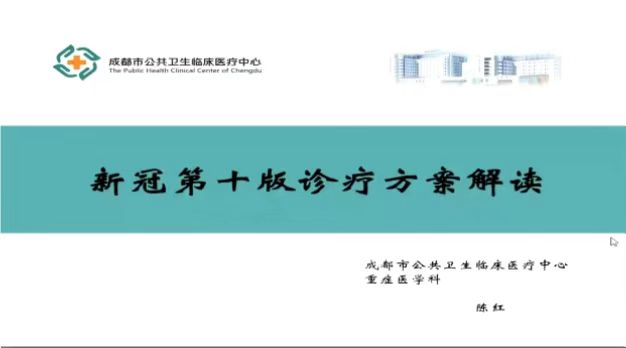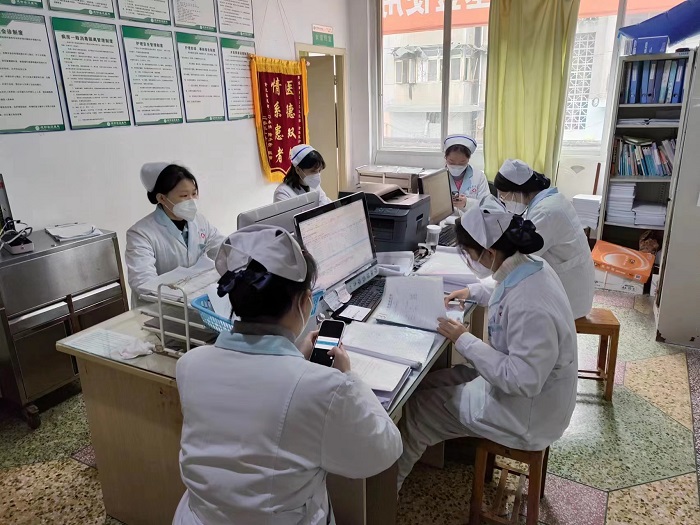In order to further scientific and standardized diagnosis and treatment of novel coronavirus infection, the National Health Commission and the National Administration of Traditional Chinese Medicine released the Diagnosis and Treatment Protocol for Novel Coronavirus Infection (Trial Version 10) on January 6, 2023. In light of the characteristics and current situation of the transmission of the Omicron variant, the National Health Commission and the State Administration of Traditional Chinese Medicine organized experts to revise the ninth version of the protocol, forming the Diagnosis and Treatment Protocol for Novel Coronavirus Infection (Trial Version 10). Chengdu High-tech Zone Medical Quality Control Management Service Center responded quickly and launched online training of the tenth version of the new diagnosis and treatment plan for 17 medical quality control sub-centers and medical institutions at all levels in the morning of January 7th.

Medical staff from medical institutions in the district watched the training video produced by the municipal Public Health Center and had a detailed understanding of the revised content in the new program. Under the current situation of the epidemic, it is really necessary to have a treatment guideline, to give confidence to the medical staff, as well as to the patients, to overcome the difficulties together!

What are the features of the new diagnosis and treatment protocol? What are the key revisions?
First, the name of the disease has been adjusted. Changing the name of the disease from "novel coronavirus pneumonia" to "novel coronavirus infection" can more accurately reflect the characteristics of the disease.
Second, "suspected cases" will no longer be judged. At present, COVID-19 infection can be diagnosed timely, quickly and accurately through nucleic acid and antigen detection. In the vast majority of cases, there will not be a situation where the etiological detection cannot be clear for a long time due to the epidemiological history and clinical manifestations that are consistent with the characteristics of the disease.
Third, add positive test for novel coronavirus antigen as diagnostic criteria. Antigen detection has better sensitivity for infected persons with high viral load. With the continuous maturation of antigen detection technology and the continuous improvement of detection accuracy, COVID-19 patients, especially those with high infectivity, can be diagnosed timely through antigen detection.
Fourth, further optimize the "clinical classification". Mainly according to the severity of infected patients, they are divided into "light, medium, severe and critical", which is more in line with clinical practice.
Fifth, no longer requires "centralized isolation and treatment" of cases. With the implementation of Class B and B measures, those infected with the novel coronavirus can choose to receive home treatment or seek medical treatment in medical institutions according to their needs, and all kinds of medical institutions can receive and treat those infected with the novel coronavirus.
Sixth, it further improved the treatment method. First, the anti-COVID-19 drugs already approved for sale in China will be included in the new version of diagnosis and treatment protocols to further enrich anti-viral treatment means. Second, the diagnostic criteria and warning indicators for severe and critical cases were further improved. Third, further strengthen the concept of co-treatment of COVID-19 infection and underlying diseases. Fourthly, the clinical manifestations and treatment of children cases were further optimized. Fifth, it further improves the content of TCM treatment.
Seventh, adjust "discharge standard". When the patient's condition has improved significantly, vital signs are stable, body temperature is normal for more than 24 hours, lung imaging shows significant improvement of acute exudative lesions, can be transferred to oral drug therapy, and there are no complications requiring further management, the patient can be considered for discharge.
Eighth, adjust infection prevention and control in medical institutions. First, further implement the outpatient and emergency pre-examination triage system, and do a good job of patient triage. Second, strengthen the consultation room, ward, office and duty room and other areas clean disinfection and ventilation. The third is to implement the personal protection requirements of medical personnel according to the exposure risk. Fourth, standardize the treatment of medical waste and implement terminal disinfection of patients after transfer or discharge from hospital.








